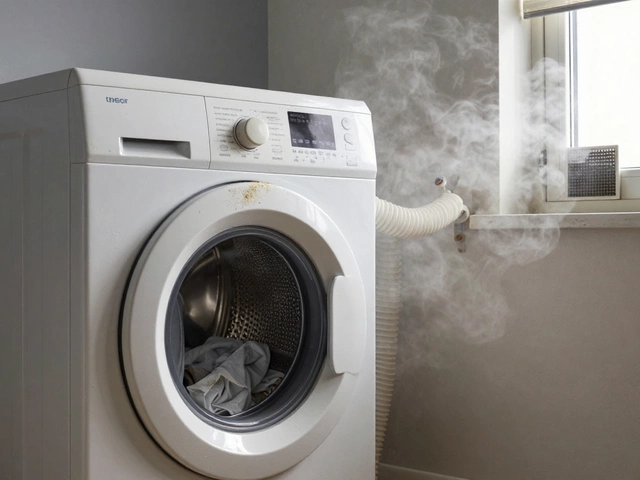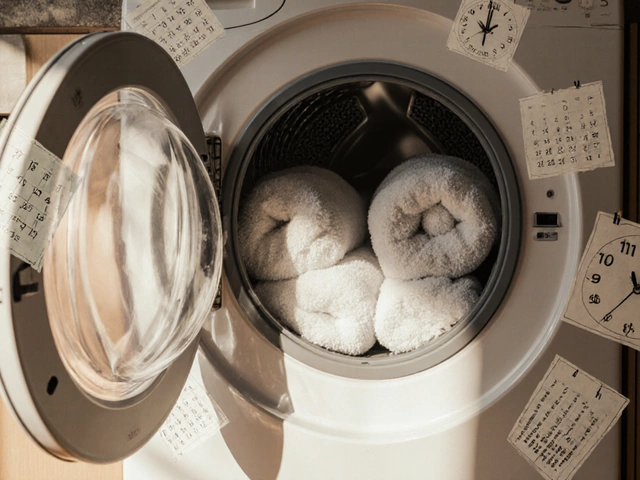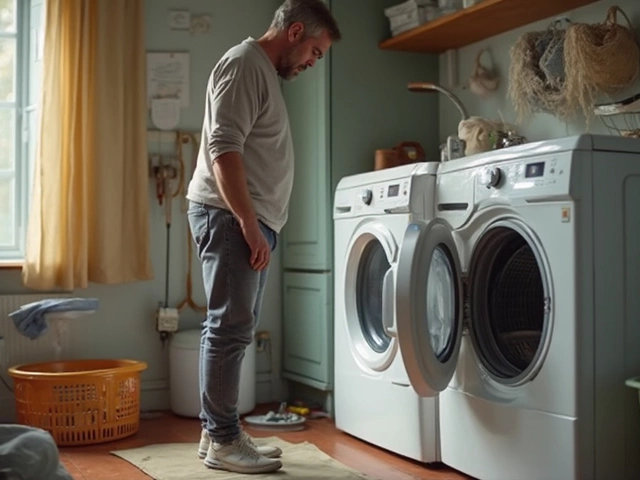So your dryer is on its tenth birthday and suddenly refuses to dry a single sock. Do you shell out for a fix, or is it smarter to stash that cash for a new one? Before you make a move, know this—most dryers hover around that 10–13 year lifespan. If you’re near the upper end, it all comes down to the type of problem and repair costs.
Quick tip: If it’s something simple like a new belt or thermostat, you might be looking at less than $150. But if the motor’s shot or it needs major electrical work, repair bills can hit $300 easy. Not every broken dryer is a goner, but not every old dryer deserves a second chance, either.
People think an old dryer always uses more electricity, too, but that depends. Some older models are just as efficient if they’re running smoothly. If you’re worried about safety (think: smells of burning, weird noises, or excessive heat), don’t take chances—get a pro to look.
- How Long Do Dryers Last?
- When to Call It Quits: Signs Your Dryer Is Done
- Repair Costs: What Should You Expect?
- Should You Fix or Replace? Making the Choice
How Long Do Dryers Last?
Here’s the deal: most dryers are built to keep chugging for 10 to 13 years if you don’t skip basic maintenance. The actual number can swing a bit, but 12 years is the average sweet spot for both electric and gas models. If your machine is already 10 years old, it’s officially in the later part of its working life. But age doesn’t always mean it’s time to say goodbye.
How much you use your dryer matters a lot. Someone with a big family tossing in loads every day will run into issues a lot sooner than a single person who only does laundry once a week. The other thing folks forget? Lint. Clogged filters and vents mess up performance and chip away at your dryer’s life span.
| Dryer Type | Average Lifespan (years) |
|---|---|
| Electric | 11-13 |
| Gas | 10-12 |
Here’s a quick breakdown of how to make your dryer last as long as possible:
- Clean the lint trap after every single load—it’s one minute that saves a lot of trouble.
- Check and clean the vent hose every few months. Lint buildup is bad news for efficiency and safety.
- Don’t overload it. Big loads just stress parts and slow everything down.
- If you notice weird noises, vibrations, or clothes staying wet, get a checkup before things get worse.
So, should you fix your dryer repair issues if your machine's pushing 10 years? If you’ve been taking care of it, maybe! If it’s been limping along for months, start comparing repair prices to replacement costs. Lifespan isn’t everything, but it’s a big piece of the puzzle.
When to Call It Quits: Signs Your Dryer Is Done
Let’s keep it real—nobody wants to spend money fixing something that’s on its last legs. How do you know for sure when your dryer is circling the drain? If you spot more than one of these issues, it’s probably time to let go.
- Dryer repair bills keep stacking up every few months. If you’ve paid for more than two repairs in a year, you’re better off investing in a new unit.
- The drum doesn’t turn, clothes come out damp after a full cycle, or it just shuts off mid-job. These can mean major part failures—usually not worth the money to fix in older machines.
- Burning smells or sparks are a big red flag. This isn’t just about inconvenience—it’s a fire hazard. Time to unplug and call it quits.
- Insanely loud banging, grinding, or squealing noises typically point to failing components, not loose change in the drum.
- The door won’t seal, or the controls and displays no longer respond. Modern fixes for electronic panels can be nearly as expensive as a new dryer.
To give you a rough idea, here’s a quick breakdown of when most folks bite the bullet and upgrade to a new model:
| Issue | Common Age at Failure | % Owners Replace Dryer |
|---|---|---|
| Major motor failure | 9–12 years | 72% |
| Heating element burnout | 7–11 years | 63% |
| Control panel or electronic faults | 10–15 years | 85% |
| Drum or bearing failure | 8–13 years | 78% |
There’s an old rule: If your repair will cost more than half the price of a new dryer, it’s not worth it. Dryers aren’t like classic cars—fixing them usually doesn’t add value. If your machine is acting up and the price tag to fix it makes you wince, it’s smart to price out replacements instead of sinking more cash in a dying appliance.

Repair Costs: What Should You Expect?
Let’s get down to numbers. The price for fixing a dryer repair can swing everywhere between $100 and $400, depending on the problem. It’s not just about what’s broken—it’s also about what your local repair shop charges for labor and if they need to order special parts. The age and brand of your dryer matter, too. Some brands are infamous for expensive replacement parts.
Here's a handy table that shows real numbers for the most common dryer repairs:
| Repair Type | Average Cost (USD) |
|---|---|
| Thermal fuse replacement | $80 - $130 |
| Drum belt replacement | $120 - $180 |
| Heating element | $150 - $260 |
| Motor replacement | $250 - $400 |
| Rollers or bearings | $110 - $200 |
Keep in mind, if your repair bill is creeping up to half the cost of a new dryer (new units start around $400 for entry-level models), it’s smart to pause and weigh your options. Another tip—do a quick online search for your model’s common issues. If certain parts keep breaking, those constant fixes can add up fast.
If you’re handy with tools, you can save on labor by swapping out smaller parts yourself. DIY repairs, like switching a drum belt or a fuse, can turn a $150 repair into a $30 part and a couple of hours on a Saturday. There are step-by-step videos and forums for almost every brand out there.
One last thing: Ask the repair tech if the part comes with a warranty. Some parts only have a 90-day guarantee, while others give you a full year of coverage. It’s worth knowing so you don’t pay twice for the same problem down the line.
Should You Fix or Replace? Making the Choice
When it comes to a 10 year old dryer, the decision basically comes down to money, convenience, and safety. Repairs are fine for minor stuff, but if fixing it costs half—or more—of what a new dryer goes for, it’s time to think hard. According to real numbers, the average national cost for dryer repairs in 2024 runs between $100 and $430, but major parts like a drum or motor usually land at the upper end of that scale.
Here’s what matters when choosing to repair or replace your dryer:
- Cost of Repair vs. Cost of New: If you're quoted $300+ and a basic new dryer starts around $500–$600, ask yourself if it’s worth investing more in a decade-old machine.
- Age & Lifespan: Dryers typically last 10–13 years. If you’re bumping up against that, new problems could start stacking up soon.
- Frequency of Breakdowns: If this isn't your first breakdown of the year, expect more. Replacement saves you ongoing hassle and bills.
- Energy Use: Older dryers can be less efficient, which means higher electric bills. New dryers (especially Energy Star models) can cut power use up to 20%.
- Safety Issues: Noisy operation, strong burning smells, or clothes coming out scorching hot are red flags. Safety trumps savings every time—don’t hesitate to jump to replacement for serious issues.
| Repair Type | Average Cost ($) | Worth Repairing? |
|---|---|---|
| Belt/Timer/Switch | 80 - 150 | Yes, usually |
| Heating Element | 150 - 280 | Maybe, depends on dryer |
| Motor/Drum | 250 - 430 | No, consider replacement |
Here’s a quick checklist for making the call:
- Get a solid cost estimate before saying yes to any repair.
- Check your dryer's age—over 10 years and having issues? Lean toward replacement.
- Ask how many breakdowns you’ve had in the past year—if it’s more than two, replacement often saves you money and frustration.
- Factor in energy savings with new models. Sometimes, that alone pays for a new dryer after a few years.
If you’re stuck between “fix” and “replace,” think about how much you rely on laundry at home. Constant surprises aren't fun—sometimes, new is just simpler and cheaper in the long run.




